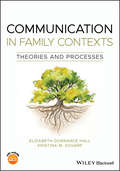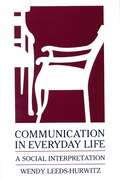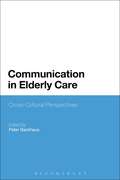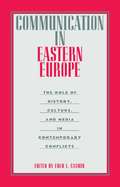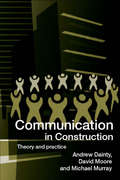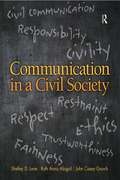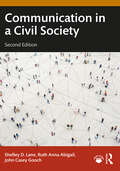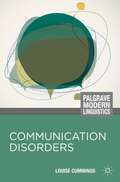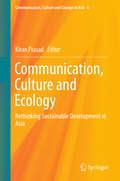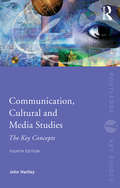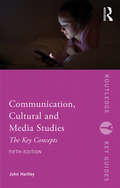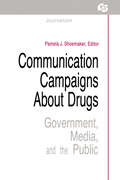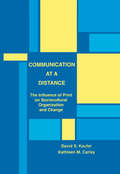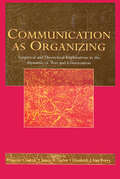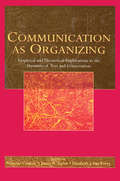- Table View
- List View
Communication in Family Contexts: Theories and Processes
by Elizabeth Dorrance Hall Kristina M. ScharpAn innovative, student-friendly textbook covering the major elements of the field of Family Communication Family Communication, a rapidly growing sub-discipline within Communication Studies, explores the processes and factors involved in family interactions and relationships. Communication in Family Contexts is a clear and accessible survey of the essential principles, theories, and concepts of the field. Unlike textbooks that present a vast amount of material across only a few chapters—this innovative textbook features brief, easily-understood chapters ideally-suited for undergraduate courses on the subject. The text provides concise yet comprehensive coverage of a diverse range of topics, from fundamental aspects of caretaking and sibling communication, to topics not covered in other textbooks such as estrangement and marginalization. 33 chapters cover theories of family communication, family communication processes, and communicating in family relationships. The authors, noted researchers and educators in the field, complement discussions of standard topics with those of growing contemporary interest, such as LGBTQ family communication, step-family and half-sibling relationships, and the influence of technology on family. This textbook: Provides a well-rounded examination of the major elements of Family Communication studies Explains the foundational theories of the field, including Family Communication Patterns Theory and Relational Dialectics Theory Features numerous practical application exercises to enable students apply theory to practice Includes a complete set pedagogical features, such as case studies, visualizations and models of theories, illustrations, and discussion questions Offers a flexible organizational structure that allows instructors to pick and choose chapters to meet the needs of their courses Communication in Family Contexts: Theories and Processes is an important resource for instructors and students in the field of family communication, the wider discipline of Communication Studies, and related areas such as social psychology and sociology.
Communication in Everyday Life: A Social Interpretation
by Wendy Leeds-Hurwitz(This book) is a clearly written and well-documented review of social communication theory, and an alternative to texts which focus primarily on the psychology of interpersonal communication and tend to exclude the social perspective on understanding interpersonal communication. Leeds-Hurwitz provides a welcome addition to introductory texts on the study of human communication. (This) is for teachers who have searched for an introductory textbook which presents a comprehensive argument for a social interactionist perspective on communication in a way understandable to students. Most refreshing is that Leeds-Hurwitz does not talk down to the reader, integrates (not just cites) original sources, and illustrates the concepts with ethnographic research…. Mark Kuhn, University of Maine, Orono in Communication Education
Communication in Elderly Care: Cross-Cultural Perspectives
by Peter BackhausThe topic of communication in elderly care is becoming ever more pressing, with an aging world population and burgeoning numbers of people needing care. This book looks at this critical but underanalyzed area. It examines the way people talk to each other in eldercare settings from an interdisciplinary and globally cross-cultural perspective. The small body of available research points to eldercare communication taking place with its own specific conditions and contexts. Often, there is the presence of various mental/physical ailments on the part of the care receivers, scarcity of time, resources and/or flexibility on the part of the care givers, and a mutual necessity of providing/receiving assistance with intimate personal activities.The book combines theory and practice, with linguistically informed analysis of real-life interaction in eldercare settings across the world. Each chapter closes with a "Practical Recommendations" section that contains suggestions on how communication in eldercare can be improved. This book is an important and timely publication that will appeal to researchers and carers alike.
Communication in Elderly Care: Cross-Cultural Perspectives (Continuum Studies In Linquistics Ser.)
by Peter BackhausThe topic of communication in elderly care is becoming ever more pressing, with an aging world population and burgeoning numbers of people needing care. This book looks at this critical but underanalyzed area. It examines the way people talk to each other in eldercare settings from an interdisciplinary and globally cross-cultural perspective. The small body of available research points to eldercare communication taking place with its own specific conditions and contexts. Often, there is the presence of various mental/physical ailments on the part of the care receivers, scarcity of time, resources and/or flexibility on the part of the care givers, and a mutual necessity of providing/receiving assistance with intimate personal activities.The book combines theory and practice, with linguistically informed analysis of real-life interaction in eldercare settings across the world. Each chapter closes with a "Practical Recommendations" section that contains suggestions on how communication in eldercare can be improved. This book is an important and timely publication that will appeal to researchers and carers alike.
Communication in Eastern Europe: The Role of History, Culture, and Media in Contemporary Conflicts (Routledge Communication Series)
by Fred L. CasmirThis volume represents a clear attempt to learn something from the events in Eastern European countries. It does not start with simplistic or old assumptions based on convenient Western communication models, but instead takes a new approach. If chaos theory could fundamentally change how physicists looked at order in the universe, then it may be of value for communication scholars to attempt to understand the diversity of chaos or order in the human universe, rather than attempt to force existing models on it for their own explanatory purposes. This book is not merely based on the study of select groups of university students or on laboratory settings created in the minds of social scientists. It seeks to understand some of the "real world," including the historical backgrounds and the theoretical assumptions brought to studies of intercultural conflicts. Using personal and professional insights developed during firsthand contacts with existing situations, chapter authors illustrate some of the realities by using the complexity of changes in Eastern European states during the final decade of the 20th century. From education to business, from the role of women to the role of mass media, from the impact of political systems to the impact of history, communication between those who are culturally diverse, though they may have been arbitrarily forced to live under the same "political roof," is the theme of these scholarly studies. The editor's reason for developing this volume of original essays is his belief that diversity rather than assumed similarity or even sameness -- based on the use of inadequate terminology -- is necessary for learning from contemporary human experiences. He further believes that diversity and the significant roles of cultural values as well as of history need to become key concepts in the model with which to begin when it comes to the study of various aspects of intercultural communication. It is therefore vital that scholars who represent various points of view and backgrounds contribute to that process. After all, understanding what is happening in the world is centrally anchored in or related to effective and successful "intercultural" communication between scholars who have different academic and personal backgrounds.
Communication in Eastern Europe: The Role of History, Culture, and Media in Contemporary Conflicts (Routledge Communication Series)
by Fred L. CasmirThis volume represents a clear attempt to learn something from the events in Eastern European countries. It does not start with simplistic or old assumptions based on convenient Western communication models, but instead takes a new approach. If chaos theory could fundamentally change how physicists looked at order in the universe, then it may be of value for communication scholars to attempt to understand the diversity of chaos or order in the human universe, rather than attempt to force existing models on it for their own explanatory purposes. This book is not merely based on the study of select groups of university students or on laboratory settings created in the minds of social scientists. It seeks to understand some of the "real world," including the historical backgrounds and the theoretical assumptions brought to studies of intercultural conflicts. Using personal and professional insights developed during firsthand contacts with existing situations, chapter authors illustrate some of the realities by using the complexity of changes in Eastern European states during the final decade of the 20th century. From education to business, from the role of women to the role of mass media, from the impact of political systems to the impact of history, communication between those who are culturally diverse, though they may have been arbitrarily forced to live under the same "political roof," is the theme of these scholarly studies. The editor's reason for developing this volume of original essays is his belief that diversity rather than assumed similarity or even sameness -- based on the use of inadequate terminology -- is necessary for learning from contemporary human experiences. He further believes that diversity and the significant roles of cultural values as well as of history need to become key concepts in the model with which to begin when it comes to the study of various aspects of intercultural communication. It is therefore vital that scholars who represent various points of view and backgrounds contribute to that process. After all, understanding what is happening in the world is centrally anchored in or related to effective and successful "intercultural" communication between scholars who have different academic and personal backgrounds.
Communication in Construction: Theory and Practice
by Andrew Dainty David Moore Michael MurrayCommunication within project-based environments presents special challenges. This is especially true within the construction industry, where interaction tends to be characterised by unfamiliar groups of people coming together for short periods before disbanding to work on other endeavours. This book examines communication at a number of levels ranging from interpersonal interactions between project participants to corporate communication between organizations. Several non-typical perspectives on the process of communication are introduced to encourage the reader to think about communication in a more innovative manner. The combination of differing perspectives illustrates the diversity of communication problems facing those working within project-based environments. Practical guidance is provided on possible solutions to communication problems, and a number of examples and case studies are presented.
Communication in Construction: Theory and Practice
by Andrew Dainty David Moore Michael MurrayCommunication within project-based environments presents special challenges. This is especially true within the construction industry, where interaction tends to be characterised by unfamiliar groups of people coming together for short periods before disbanding to work on other endeavours. This book examines communication at a number of levels ranging from interpersonal interactions between project participants to corporate communication between organizations. Several non-typical perspectives on the process of communication are introduced to encourage the reader to think about communication in a more innovative manner. The combination of differing perspectives illustrates the diversity of communication problems facing those working within project-based environments. Practical guidance is provided on possible solutions to communication problems, and a number of examples and case studies are presented.
Communication in a Civil Society
by John Gooch Ruth Anne Abigail Shelley D. LaneFirst Published in 2016. Routledge is an imprint of Taylor & Francis, an Informa company.
Communication in a Civil Society
by John Gooch Ruth Anne Abigail Shelley D. LaneFirst Published in 2016. Routledge is an imprint of Taylor & Francis, an Informa company.
Communication in a Civil Society
by Shelley D. Lane Ruth Anna Abigail John Casey GoochUsing the concept of “civility” as the major theme, this fully updated second edition offers a unique and alternative way to teach and learn about communication.The book brings together discrete areas that explore the fundamentals of communication and intrapersonal communication, interpersonal communication, small group communication, and public speaking. Every chapter includes theories, concepts, and examples that allow students to use civil and ethical communication skills in their personal relationships, in collaboration with colleagues, and in giving public speeches and professional presentations. This new edition highlights advances in and concepts related to mediated and technology-based communication, such as chatbots, technostress, and dating apps, and shows how students can engage in civil face-to-face and mediated interaction. Additionally, each chapter includes a real-world incident that students are asked to analyze in terms of specific chapter information and skills related to civility.Communication in a Civil Society is an ideal textbook for Introduction to Communication, Interpersonal Communication, and Public Speaking courses.Materials for instructors including PowerPoint slides, a test bank, and an instructor’s manual, are available at www.routledge.com/9781032513263.
Communication in a Civil Society
by Shelley D. Lane Ruth Anna Abigail John Casey GoochUsing the concept of “civility” as the major theme, this fully updated second edition offers a unique and alternative way to teach and learn about communication.The book brings together discrete areas that explore the fundamentals of communication and intrapersonal communication, interpersonal communication, small group communication, and public speaking. Every chapter includes theories, concepts, and examples that allow students to use civil and ethical communication skills in their personal relationships, in collaboration with colleagues, and in giving public speeches and professional presentations. This new edition highlights advances in and concepts related to mediated and technology-based communication, such as chatbots, technostress, and dating apps, and shows how students can engage in civil face-to-face and mediated interaction. Additionally, each chapter includes a real-world incident that students are asked to analyze in terms of specific chapter information and skills related to civility.Communication in a Civil Society is an ideal textbook for Introduction to Communication, Interpersonal Communication, and Public Speaking courses.Materials for instructors including PowerPoint slides, a test bank, and an instructor’s manual, are available at www.routledge.com/9781032513263.
Communication Disorders (Modern Linguistics)
by Louise CummingsWhat are communication disorders? How are they identified, assessed and treated? This introductory textbook presents the full range of developmental and acquired communication disorders, including specific language impairment, dysarthria, apraxia of speech, aphasia and stuttering. Covering clinical features, diagnosis and treatment, the book is an indispensable resource for students of linguistics, and speech and language therapy. Communication Disorders also: - includes clinical linguistic data throughout to illustrate specific features of communication disorders- discusses disorders often neglected in introductory books, such as glossectomy and gender dysphoria- contains in-text references to a companion website which has colour photographs, audio and video files, and 200 self-test questions - provides exercises with answers, key point boxes, case studies, suggested readings and a glossary
Communication Disorders (Macmillan Modern Linguistics)
by Louise CummingsWhat are communication disorders? How are they identified, assessed and treated?This introductory textbook presents the full range of developmental and acquired communication disorders, including specific language impairment, dysarthria, apraxia of speech, aphasia and stuttering. Covering clinical features, diagnosis and treatment, the book is an indispensable resource for students of linguistics, and speech and language therapy.Communication Disorders also: - Includes clinical linguistic data throughout to illustrate specific features of communication disorders- discusses disorders often neglected in introductory books, such as glossectomy and gender dysphoria- Contains in-text references to a companion website which has colour photographs, audio and video files, and 200 self-test questions - Provides exercises with answers, key point boxes, case studies, suggested readings and a glossary
Communication, Culture and Ecology: Rethinking Sustainable Development in Asia (Communication, Culture and Change in Asia #6)
by Kiran PrasadThis book offers comprehensive insights into the cultural and ecological values that influence sustainable development across Asia, addressing the cultural, religious and philosophical moorings of development through participatory and grassroots communication approaches. It presents a range of contributions and case studies from leading experts in Asia to highlight the debates on environmental communication and sustainable development that are relevant today, and to provide an overview of the positive traditions of ecological sensitivity and cultural communication that may find common ground between communities. This well-researched guide to the dynamic and complex terrain of communication for sustainable development offers uniquely practical perspectives on communication, environment and sustainable development that are of immense value for policy makers, media scholars, development practitioners, researchers and students of communication and media studies.
Communication, Cultural and Media Studies: The Key Concepts (Routledge Key Guides)
by John HartleyThis fourth edition of Communication, Cultural and Media Studies: The Key Concepts is an indispensible guide to the most important terms in the field. It offers clear explanations of the key concepts, exploring their origins, what they’re used for and why they provoke discussion. The author provides a multi-disciplinary explanation and assessment of the key concepts, from ‘authorship’ to ‘censorship’; ‘creative industries’ to ‘network theory’; ‘complexity’ to ‘visual culture’. The new edition of this classic text includes: Over 200 entries including 50 new entries All entries revised, rewritten and updated Coverage of recent developments in the field Insight into interactive media and the knowledge-based economy A fully updated bibliography with 400 items and suggestions for further reading throughout the text
Communication, Cultural and Media Studies: The Key Concepts (Routledge Key Guides)
by John HartleyThis fourth edition of Communication, Cultural and Media Studies: The Key Concepts is an indispensible guide to the most important terms in the field. It offers clear explanations of the key concepts, exploring their origins, what they’re used for and why they provoke discussion. The author provides a multi-disciplinary explanation and assessment of the key concepts, from ‘authorship’ to ‘censorship’; ‘creative industries’ to ‘network theory’; ‘complexity’ to ‘visual culture’. The new edition of this classic text includes: Over 200 entries including 50 new entries All entries revised, rewritten and updated Coverage of recent developments in the field Insight into interactive media and the knowledge-based economy A fully updated bibliography with 400 items and suggestions for further reading throughout the text
Communication, Cultural and Media Studies: The Key Concepts (Routledge Key Guides)
by John HartleyNow in its fifth edition, this pioneering volume of Routledge’s ‘Key Concepts’ series offers clear explanations of key concepts, showing where they came from, what they are used for, and why they provoke discussion or disagreement. The new edition is extensively revised to keep pace with rapidly evolving developments in communication, culture and media, providing topical and authoritative guidance to transformational shifts from broadcast to digital technologies, national to global media and disciplinary to diverse knowledge. It includes: Nearly 250 entries, covering what and how to study across this multi-disciplinary field 50 new entries: from algorithm and assemblage, dance and data, to woke and worldbuilding Updated references with 500 items and suggestions for further reading Revisions, updates and examples throughout. For students and seasoned scholars alike, Communication, Cultural and Media Studies is an invaluable resource in an ever-changing landscape.
Communication, Cultural and Media Studies: The Key Concepts (Routledge Key Guides)
by John HartleyNow in its fifth edition, this pioneering volume of Routledge’s ‘Key Concepts’ series offers clear explanations of key concepts, showing where they came from, what they are used for, and why they provoke discussion or disagreement. The new edition is extensively revised to keep pace with rapidly evolving developments in communication, culture and media, providing topical and authoritative guidance to transformational shifts from broadcast to digital technologies, national to global media and disciplinary to diverse knowledge. It includes: Nearly 250 entries, covering what and how to study across this multi-disciplinary field 50 new entries: from algorithm and assemblage, dance and data, to woke and worldbuilding Updated references with 500 items and suggestions for further reading Revisions, updates and examples throughout. For students and seasoned scholars alike, Communication, Cultural and Media Studies is an invaluable resource in an ever-changing landscape.
Communication Campaigns About Drugs: Government, Media, and the Public (Routledge Communication Series)
by Pamela J. ShoemakerPublished in 1989, Communication Campaigns About Drugs is a valuable contribution to the field of Communication Studies.
Communication Campaigns About Drugs: Government, Media, and the Public (Routledge Communication Series)
by Pamela J. ShoemakerPublished in 1989, Communication Campaigns About Drugs is a valuable contribution to the field of Communication Studies.
Communication at A Distance: The Influence of Print on Sociocultural Organization and Change (Routledge Communication Series)
by David S. Kaufer Kathleen M. CarleyThis book bridges an important gap between two major approaches to mass communication -- historical and social scientific. To do so, it employs a theory of communication that unifies social, cultural and technological concerns into a systematic and formal framework that is then used to examine the impact of print within the larger socio-cultural context and across multiple historical contexts. The authors integrate historical studies and more abstract formal representations, achieving a set of logically coherent and well-delimited hypotheses that invite further exploration, both historically and experimentally. A second gap that the book addresses is in the area of formal models of communication and diffusion. Such models typically assume a homogeneous population and a communication whose message is abstracted from the complexities of language processing. In contrast, the model presented in this book treats the population as heterogeneous and communications as potentially variable in their content as they move across speakers or readers. Written to address and overcome many of the disciplinary divisions that have prevented the study of print from being approached from the perspective of a unified theory, this book employs a focused interdisciplinary position that encompasses several domains. It shows the underlying compatibility between cognitive and social theory; between the study of language and cognition and the study of technology; between the postmodern interest in the instability of meaning and the social science interest in the diffusion of information; between the effects of technology and issues of cultural homogeneity and heterogeneity. Overall, this book reveals how small, relatively non-interactive, disciplinary-specific conversations about print are usefully conceived of as part of a larger interdisciplinary inquiry.
Communication at A Distance: The Influence of Print on Sociocultural Organization and Change (Routledge Communication Series)
by David S. Kaufer Kathleen M. CarleyThis book bridges an important gap between two major approaches to mass communication -- historical and social scientific. To do so, it employs a theory of communication that unifies social, cultural and technological concerns into a systematic and formal framework that is then used to examine the impact of print within the larger socio-cultural context and across multiple historical contexts. The authors integrate historical studies and more abstract formal representations, achieving a set of logically coherent and well-delimited hypotheses that invite further exploration, both historically and experimentally. A second gap that the book addresses is in the area of formal models of communication and diffusion. Such models typically assume a homogeneous population and a communication whose message is abstracted from the complexities of language processing. In contrast, the model presented in this book treats the population as heterogeneous and communications as potentially variable in their content as they move across speakers or readers. Written to address and overcome many of the disciplinary divisions that have prevented the study of print from being approached from the perspective of a unified theory, this book employs a focused interdisciplinary position that encompasses several domains. It shows the underlying compatibility between cognitive and social theory; between the study of language and cognition and the study of technology; between the postmodern interest in the instability of meaning and the social science interest in the diffusion of information; between the effects of technology and issues of cultural homogeneity and heterogeneity. Overall, this book reveals how small, relatively non-interactive, disciplinary-specific conversations about print are usefully conceived of as part of a larger interdisciplinary inquiry.
Communication as Organizing: Empirical and Theoretical Explorations in the Dynamic of Text and Conversation (Routledge Communication Series)
by François Cooren James R. Taylor Elizabeth J. Van EveryCommunication as Organizing unites multiple reflections on the role of language under a single rubric: the organizing role of communication. Stemming from Jim Taylor's earlier work, The Emergent Organization: Communication as Its Site and Surface (LEA, 2000), the volume editors present a communicational answer to the question, "what is an organization?" through contributions from an international set of scholars and researchers. The chapter authors synthesize various lines of research on constituting organizations through communication, describing their explorations of the relation between language, human practice, and the constitution of organizational forms. Each chapter develops a dimension of the central theme, showing how such concepts as agency, identity, sensemaking, narrative and account may be put to work in discursive analysis to develop effective research into organizing processes. The contributions employ concrete examples to show how the theoretical concepts can be employed to develop effective research. This distinctive volume encourages readers to discover and develop a truly communicational means of addressing the question of organization, addressing how organization itself emerges in the course of communicational transactions. In presenting a single and entirely communicational perspective for exploring organizational phenomena, grounded in the discourse of communicational transactions and the establishment of relationships through language, it is required reading for scholars, researchers, and graduate students working in organizational communication, management, social psychology, pragmatics of language, and organizational studies.
Communication as Organizing: Empirical and Theoretical Explorations in the Dynamic of Text and Conversation (Routledge Communication Series)
by Francois Cooren James R. Taylor Elizabeth J. Van EveryCommunication as Organizing unites multiple reflections on the role of language under a single rubric: the organizing role of communication. Stemming from Jim Taylor's earlier work, The Emergent Organization: Communication as Its Site and Surface (LEA, 2000), the volume editors present a communicational answer to the question, "what is an organization?" through contributions from an international set of scholars and researchers. The chapter authors synthesize various lines of research on constituting organizations through communication, describing their explorations of the relation between language, human practice, and the constitution of organizational forms. Each chapter develops a dimension of the central theme, showing how such concepts as agency, identity, sensemaking, narrative and account may be put to work in discursive analysis to develop effective research into organizing processes. The contributions employ concrete examples to show how the theoretical concepts can be employed to develop effective research. This distinctive volume encourages readers to discover and develop a truly communicational means of addressing the question of organization, addressing how organization itself emerges in the course of communicational transactions. In presenting a single and entirely communicational perspective for exploring organizational phenomena, grounded in the discourse of communicational transactions and the establishment of relationships through language, it is required reading for scholars, researchers, and graduate students working in organizational communication, management, social psychology, pragmatics of language, and organizational studies.
